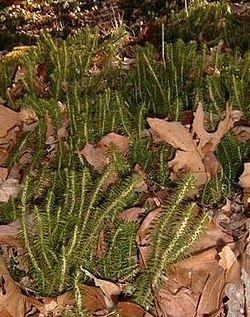Kingdom Plantae Class Lycopodiopsida Rank Family | Division Lycopodiophyta Order Lycopodiales | |
 | ||
Similar Huperzia, Huperzia selago, Lycopodiaceae, Lycopodiales, Huperzia serrata | ||
The family Huperziaceae is one of two families sometimes recognized in the order Lycopodiales, and contains two or three extant genera:
The genera of Huperziaceae are included in the family Lycopodiaceae in several classifications (in fact older classifications included the species of Huperzia within Lycopodium) and there is as yet no consensus as to whether Huperziaceae should be recognized as a distinct family. The plants are distinct from those of Lycopodiaceae s.s. in having erect (not creeping) growth; and in its spore-bearing structures being produced in the axils of unmodified leaves, unlike the terminal club-like structure produced by species in the Lycopodiaceae. The family also has a basal chromosome count of n=67, versus counts of n=23, 34 in the Lycopodiaceae.
